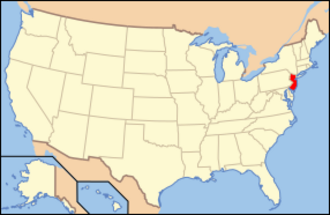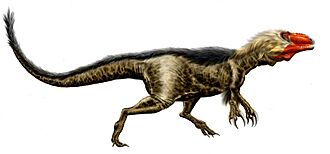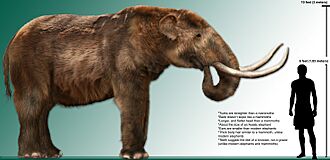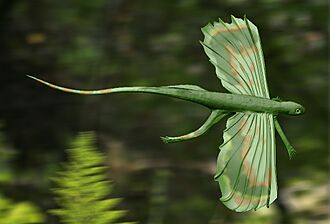Paleontology in New Jersey facts for kids

New Jersey is a great place to find fossils! Paleontology is the study of ancient life, and New Jersey has many amazing discoveries. The state is especially rich in fossils from old seas.
Millions of years ago, during the Precambrian time, New Jersey was covered by a shallow sea. Tiny bacteria formed special layered rocks called stromatolites in these waters. Later, in the early Paleozoic Era, the sea was still here. It was home to creatures like shellfish called brachiopods and ancient crab-like creatures called trilobites. By the Silurian Period, northern New Jersey had a river system. Sea levels changed a lot during the rest of the Paleozoic Era. There are no rocks from the Carboniferous or Permian periods here, so no fossils from those times.
During the Triassic Period, New Jersey was dry land. Large lakes formed, and these lakes were home to shrimp-like creatures called Cyzicus and fish like Diplurus. On land, dinosaurs left behind their footprints. They continued to do so into the Jurassic Period.
A sea covered southern New Jersey during the Cretaceous Period. Many sea animals like plesiosaurs and turtles lived in its waters. Dinosaurs also roamed the land. New Jersey has some of the best Late Cretaceous fossils in the Mid-Atlantic region. Southern New Jersey remained a sea into the Cenozoic Era, where sharks and other sea creatures lived. By the Ice Age, northern New Jersey was home to huge mastodons, and glaciers covered the northern part of the state. Early Native Americans in the area found and used petrified wood. By the late 1700s, local fossils started to get scientific attention. In the mid-1800s, the famous Hadrosaurus foulkii was discovered and named. This duck-billed dinosaur from the Cretaceous Period is New Jersey's official state fossil.
Contents
Ancient Life in New Jersey


Let's take a trip back in time to see what New Jersey was like!
Precambrian and Paleozoic Eras
During the Precambrian time, New Jersey was covered by seawater. Tiny bacteria formed special layered rocks called stromatolites in these waters. In the Cambrian Period, New Jersey was still underwater. Not many fossils from this time have been found, but some include brachiopods (shellfish) and trilobites (ancient sea creatures). Stromatolites continued to grow.
During the Ordovician Period, the seas became deeper. Like the Cambrian, few fossils from this time are found in New Jersey. We have found some corals, sponges, and trilobites. Northern New Jersey had a river system during the Silurian Period. Sea levels changed, so the area was sometimes a river environment and sometimes a sea. Many Silurian fossils have been found near Clinton. The area stayed a shallow sea through the Devonian Period. This sea was home to brachiopods, bryozoans (tiny colonial animals), corals, and crinoids (sea lilies).
There are no rocks from the Carboniferous or Permian periods in New Jersey. This means no fossils from these times could be preserved here.
Mesozoic Era: Age of Dinosaurs
The Mesozoic Era was the time of dinosaurs!
Triassic Period
During the Triassic Period, the supercontinent Pangaea was breaking apart. This caused cracks in the land in New Jersey. Water filled these cracks, creating large lakes. Sometimes, reptiles living near these lakes would be preserved as fossils. Dinosaur footprints from the Triassic Period have been found. Other Triassic life included the fish Diplurus, which fossilized by the hundreds, and the shrimp-like Cyzicus, also found in large numbers. Cycads, a type of plant, were common here.
Jurassic Period
In the Jurassic Period, Pangaea was still breaking up. Lava flowed in New Jersey during this time. Dinosaurs continued to leave their footprints, which later turned into fossils.
Cretaceous Period
During the Cretaceous Period, southern New Jersey was covered by a warm sea. Invertebrates (animals without backbones) are the most common fossils from this time. These include oysters like Exogyra ponderosa and Gryphaea, other mollusks, and tube-shaped trace fossils called Halymenites major. Cephalopods (like ancient squid) were also present.
More than fifty different kinds of vertebrates (animals with backbones) from this time have been found. Shark teeth are common, but bony fish remains are rare. Sharks and rays were more common in Cretaceous New Jersey than in the western US at the same time. A swordfish-like bony fish called Protosphyraena has been found. The turtle Bothremys also lived here. Other marine vertebrates included plesiosaurs and mosasaurs (large marine reptiles).
Occasionally, fossil footprints from this age are found. Few plant fossils are known from this time. Northern New Jersey was dry land. A rich variety of plants grew there, leaving behind fossilized leaves. Insects also left fossils. Dinosaurs lived in the forests and swamps. These included duck-billed dinosaurs like Hadrosaurus, and meat-eating dinosaurs like Dryptosaurus and "Coelosaurus" antiquus. Birds were also present. Many other reptiles were found, including large crocodilians like Deinosuchus and Thoracosaurus. They left behind both footprints and bones.
Cenozoic Era: After the Dinosaurs
During the Tertiary period of the Cenozoic Era, New Jersey's climate was warmer than it is today. Southern New Jersey was still covered by seawater. Brachiopods, corals, echinoderms (like sea urchins), and sharks lived there. On land, at least eight kinds of Eocene birds lived in New Jersey. Miocene life included a brachiopod, a crustacean, and many types of clams (pelecypods) and snails (gastropods).
During the Quaternary period, northern New Jersey was covered by glaciers. Sea levels rose and fell as the glaciers melted or grew. Pleistocene deer, fish, and whale fossils have been found under the marshes of Atlantic and Cape May Counties. Huge mastodons lived in New Jersey, leaving remains in places like Mannington Township. Even areas off the Atlantic coast have mastodon remains. Mammoths also lived in the state.
History of Fossil Discoveries
People have been finding fossils in New Jersey for a long time!
Early Discoveries
One of the earliest important fossil finds happened on October 5, 1787. Caspar Wistar and Timothy Matlack showed a possible dinosaur bone found near Woodbury Creek to a scientific group in Philadelphia. In 1818, more reptile remains from the Cretaceous Period were reported. A tooth and jaw from the Navesink Formation were described. These were the first mosasaur fossils (large marine reptiles) ever found in North America.
Another early discovery helped correct a mistake about a fossil found out west. In 1830, Isaac Hays described a new fossil fish from New Jersey called Saurodon leanus. This new fish was so similar to a fossil called Saurocephalus lanciformis (found in Iowa) that Hays realized Saurocephalus was actually a fish, not a marine reptile as first thought.
Around 1838, workers digging for marl (a type of soil used as fertilizer) on John E. Hopkins' land found some Late Cretaceous bones. These bones were mostly vertebrae (backbones) and a possible shoulder blade. Mr. Hopkins wasn't very interested, and he let guests take the bones. Their names were forgotten, and the fossils were lost to science. Some rumors say they ended up as doorstops!
The Hadrosaurus Discovery
Later, in the summer of 1858, William Foulke heard about the bones found on the Hopkins farm. He was spending the summer in Haddonfield. That fall, Foulke hired a team to reopen the marl pit. About 10 feet down, they found bones!
Joseph Leidy then studied these fossils. He found 28 partial vertebrae, a complete arm bone (humerus), forearm bones (ulna and radius), parts of the hip (ilium and pubis), a complete thigh bone (femur), shin bone (tibia), and ankle bones. He also found two small jaw pieces and nine teeth. Leidy believed these were the remains of a reptile that walked on two legs and lived near rivers, but was sometimes swept out to sea. Leidy named the creature Hadrosaurus foulkii after William Foulke.
More Dinosaur Finds
In 1865, Joseph Leidy described a single tooth from a Late Cretaceous meat-eating dinosaur found at Mullica Hill. He called the animal Diplotomodon horrificus. In 1866, more dinosaur remains were found in a marl pit near Barnsboro. This discovery included parts of the lower jaws with teeth, both arm bones, the left thigh bone, shin bone, and many vertebrae. Leidy named this dinosaur Laelaps aquilunguis.
Two years later, in 1868, important things happened. Leidy worked with artist Benjamin Waterhouse Hawkins to put together the Hadrosaurus foulkii skeleton for the Academy of Natural Sciences of Philadelphia. This was the first dinosaur skeleton ever put on public display! It became one of the most popular exhibits, increasing visitors by up to 50%. Also that year, Leidy's rival, Edward Drinker Cope, showed Othniel Charles Marsh the marl pit where Laelaps was found. While there, Marsh secretly arranged for workers to send any fossils they found to him at the Yale Peabody Museum instead of to Cope. This event might have started the famous "Bone Wars" between Cope and Marsh!
1869 was another busy year. A nearly complete mastodon skeleton was found in Mannington Township. It would have been 9 feet 8 inches tall and 22 feet long! This skeleton is now at the Rutgers museum. A major dinosaur discovery also happened when Samuel Lockwood found Late Cretaceous dinosaur fossils near Union. The find was small, only the lower leg and ankle bones. Before Lockwood could send them to Marsh, Cope appeared and insisted on seeing them. Cope made drawings and notes, then quickly described the fossils as Ornithotarsus imannis before Marsh could receive them.
In 1870, Marsh named a new species of Hadrosaurus, H. minor, based on bones sent to him by his secret contacts at the Barnsboro quarry. In 1886, John Eyerman found fossil footprints near Milford. In 1896, Lewis Woolman found a 15-inch long fossil foot bone in Merchantville. He sent it to Cope, who thought it was from Ornithotarsus.
20th Century Discoveries
Early in the 1900s, a broken foot bone from a meat-eating dinosaur was found in a sand pit near the Delaware River. This Late Cretaceous fossil was given to Princeton University. Around 1914, dinosaur footprints were found at Woodbridge, but they were accidentally destroyed. In 1929, more dinosaur footprints were found at Woodbridge. These 90-million-year-old tracks are rare for the eastern United States.
The mid-1900s saw more important finds. In 1946, hundreds of fossil fish called Diplurus (a type of coelacanth) were found under Princeton University's Firestone Library. Many Cyzicus crustaceans were also found. Later, in 1966, Edwin Colbert described a small gliding lizard called Icarosaurus siefkeri, found at North Bergen.
Modern Recognition
More recently, on September 29, 1984, a monument to Hadrosaurus foulkii was placed near its discovery site in Haddonfield. This was part of a Boy Scout's project. Almost ten years later, on June 13, 1991, Governor James Florio signed a bill making Hadrosaurus foulkii the official state dinosaur of New Jersey!
In November 2014, a large group of Late Cretaceous fossils was found in a quarry in Mantua Township. Scientists think these fossils might be from the event that caused the extinction of the dinosaurs.
People in Paleontology
Born in New Jersey
- Robert T. Bakker was born in Bergen County on March 24, 1945.
- Paul E. Olsen was born in 1953.
Passed Away in New Jersey
- Carroll Lane Fenton died in New Brunswick on November 16, 1969.
- Richard H. Tedford died in Demarest on July 15, 2011.
Natural History Museums
If you want to see fossils from New Jersey, you can visit these museums:
- Morris Museum, Morristown
- New Jersey State Museum, Trenton
- Newark Museum, Newark
- Rutgers University Geology Museum, New Brunswick
Fossil Clubs and Groups
You can also join groups that love fossils:
- New Jersey Paleontological Society
- Delaware Valley Paleontological Society
- Monmouth Amateur Paleontologists Society


